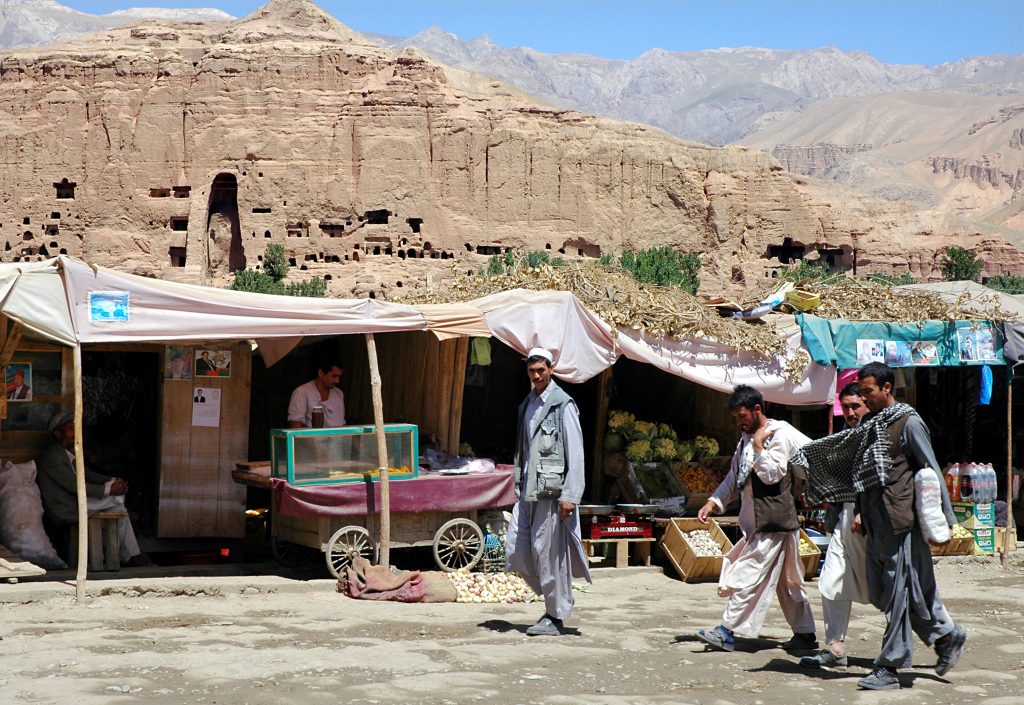 Market stall in Bamyan, Central Afghanistan. Photo: Jono Photography / Shutterstock
Market stall in Bamyan, Central Afghanistan. Photo: Jono Photography / Shutterstock
Written by Karim Merchant & Gry Synnevåg
Yet another crisis for Afghanistan
After 40 years of war and violent conflict, annual natural disasters, high unemployment, persistent poverty and food insecurity, COVID 19 has now added to Afghanistan’s health, social and economic crises, requiring urgent international community response[1].
Over half of the population is living below the poverty line and the latest WB forecast states this will have increased to 70% during 2020 due to the pandemic.
Dependence on small-scale farming
80-90% of the population rely on self-employment and derive their livelihood and income from agriculture, the agri-food chain and small businesses. Most farmers are small-scale, relying on natural resources, crops and livestock for their survival, making their livelihoods vulnerable to climate, conflict and health related shocks.
The staple crop is wheat, with most of the formal income derived from the sale of livestock, fruit, nuts and vegetables. Ongoing armed clashes with multiple actors make markets difficult to access. In some areas, conflict has made pastureland inaccessible and prevented farmers from accessing their fields. Floods and drought are recurrent, causing soil erosion and reduced yields. Irrigation structures for cropland are in some cases damaged by conflict or otherwise inaccessible.
The pandemic has reduced income from farming up to 20 % (REACH 2020), and as a coping mechanism farmers are now taking on more debt and falling deeper into poverty.
Historically, a major coping mechanism has been seeking work abroad for remittances, but the COVID-induced border closures have reduced job opportunities. Now, many more families are becoming dependent on humanitarian assistance such as food and cash distribution for their survival.
Challenges for the Afghan government
Collaborating with the international community, the Afghan government is implementing short and medium-term strategies to cope with the crushing impact of pandemic-related restrictions such as reduced overall consumption, increased agricultural unemployment and reduced remittances to rural communities that are forced to sell or consume productive assets to cope with income loss.
In addition, the government has to deal with fluctuating levels of insecurity, poor infrastructure, a lack of domestically available inputs and import controls and pandemic related border closures – all of which equate to a lack of market access for the coming seasons. This increases the activities of predatory traders and money lenders, leading to panic buying. The government must also overcome a general mistrust of the NGOs that could help increase outreach to remote rural areas.
Short and medium-term responses
In May 2020, a World Bank-funded national emergency response programme began targeting the most vulnerable beneficiary households identified with the assistance of Community Development Councils (CDCs)[2]. They will receive either cash transfers or food and hygiene packages – both equivalent to two months income. In theory, this will address some of the financial losses confronting farmers harvesting high value crops with a limited lifespan.
In between the first and second spike in COVID infections, farmers have access to cross-border markets, but this will close down again, reducing market access to district and province commercial centres in northern Afghanistan, just as they did at the beginning of the spring harvest. Lower prices resulted due to traders being unwilling to bulk buy with the aim of exporting to neighboring countries[3]. With limited post-harvest storage available for many cash crops, much will go to waste and create greater indebtedness, as farmers have to dump produce as the result of supply chain problems. Larger livestock herders are similarly affected by the lack of quality fodder and reduced offtake reducing income and increasing distress sales.
A WB-funded second phase through the Ministry of Rural Rehabilitation and Development (MRRD) will support livelihoods and economic stability of farmers through seasonal employment in the form of Cash or Food for Work at times when local labour demands are low in between agricultural activity peaks. This support will complement the ongoing Citizens Charter National Priority Program that is already transferring social development Block Grants to CDCs.[4] In areas identified as most heavily impacted by poor productive infrastructure, CDCs will identify household members on a similar criteria as the previous activity, community members will work on building local infrastructure, and this will contribute to a reduction of households shifting from acute to chronic food insecurity.
Most projects of this nature, however, will probably focus on local-level infrastructure where the quality of work is of a low standard with compacted gravel roads and rapidly rehabilitated surface water infrastructure returning to their previous condition very quickly.
A possible option to improve this approach could be to increase the budgets for these small-scale infrastructure projects, using a combination of local tendering and community-based contracting. This would ensure prolonged benefits to the community in terms of physical connectivity and access to basic irrigation structures. In addition, local labour could be recruited from the community.
Another option could also be a more creative use of cash transfers to rural communities, using a mixture of sector-specific and unconditional multi-purpose grants based on market assessments to inject cash into the local economy and stimulate on and off-farm income generation. This would help offset local loss of income and provide diverse opportunities for micro and small enterprise establishment. However, this would probably need to be undertaken by NGOs in close collaboration with CDCs, and in consultation with relevant governmental departments. In a post-conflict environment where governmental institutions are weak, NGOs usually have the comparative advantage of close collaboration with communities, local knowledge of farming habits and local market demands.
Planning for the post-COVID period
In the longer term, the agriculture sector faces a number of challenges, such as what to do with the remnants of the first and recently completed second harvest of the year.
Will enough key agricultural inputs be available to maintain or increase production for the next year with intermittent border closures and transport restrictions exacerbated by the pandemic? How will interruptions of supplies (such as seed and fertiliser) and credit, and scarcity of labour be mitigated? Although these problems are faced by commercial farmers and smallholders alike, the impact and coping mechanisms will be very different.
In the case of smallholders, such interruptions will result in increased distress sale of assets such as livestock and equipment, accompanied by an increasing debt spiral brought about by informal borrowing. Whereas commercial farmers will immediately cut costs by reducing labour and rescheduling loans from formal credit institutions and diversifying their remaining investments away from the agriculture sector. The pandemic has decreased access to credit and a stable market for both smallholder and commercial farmer alike.
At the local level, for poor households with little to no capacity to bulk-purchase or store food, frequent trips to informal market structures are often the only option. Supporting these markets to comply with hygiene measures, and ensuring access to them, is therefore crucial if they are to maintain their essential role in food distribution.
The agriculture sector is heavily reliant on imported inputs. There remains an acute shortage of certified and quality-ensured seed, along with other inputs such as fertiliser, which is being sold at 300% the normal price in some local markets. There is widespread concern over the potential impacts this will have on agriculture and livestock production.
Seed needs to be locally sourced and a greater reliance on farmer-to-farmer exchange should be encouraged. In such an emergency, local seed banks should be expanded to more communities, ensuring that smallholders do not wait for expensive improved seeds to arrive, which would create a further dependency.
Linking district level public agriculture services that provide technical support and a modest amount of government funding with active farmers who provide local knowledge and outreach to remote communities may well be the way forward.
One such model is the recently piloted Farmers Learning Resource Centre (FLRC) approach. The FLRC is a physical platform/venue for information exchange and experience sharing. Assisting in the articulation of the farmers’ demand for extension services and will provide a mechanism for linking the demand-driven service suppliers. It comprises governmental staff, farmer’s groups and individuals who are directly involved in agriculture, including the private sector. So far, it has shown great promise in linking limited extension networks to other resources, such as the CDCs, building on the knowledge and experience of farmers and building meaningful linkages with the private sector as part of a long-term strategy.
To bring in the private sector, incentives are required to engage at the district level through innovative credit and loan products.
Although Afghanistan suffers from food system constraints similar to many Fragile and Conflict Affected States, few countries have experienced such a large scale of development assistance. In fact, it has been argued that such levels of support have exceeded absorption capacity of the State and undermined the resilience factors often associated with food systems, such as self-reliance, being replaced by an increasing dependency culture when challenged by high levels of insecurity and natural disaster.
The constant emphasis on short-term measures will not address the food system constraints identified here, if medium and long-term measures are not part of the humanitarian intervention’s design.
The pandemic has exposed existing fractures in Afghan food systems, with systemic disconnect between short-term humanitarian interventions dealing with the initial shocks faced by farming communities, and the medium-term development packages that follow. In both short and medium-term approaches, much still needs to be done to ensure flexibility and inclusiveness to women and youth. In addition, the Food and Nutrition Security actors are predominantly international institutions with little governmental ownership. This remains a constraint in moving towards a more resilient systems approach to agricultural production.
Medium to long-term interventions tend to be prescriptive and top-down, with a push for market-orientated activities that overlook the fact that most farmers are smallholders, unable to collaborate with such programmes. This creates income polarization and horizontal and vertical inequity. Food insecurity, in turn, continues to create a lack of social cohesion and greater insecurity for the population.
_______________
[1] Afghanistan has been listed as having the third highest numbers of its population in a food crisis, globally speaking. According to the Global Report on Food crisis, 37% of the Afghan population (11.3 million) suffers from acute food insecurity and the number of acutely malnourished children is increasing to unacceptable levels.
[2] Community Development Councils are groups of community members elected by the community to serve as its decision-making body. The CDC is the social and development foundation at community level, responsible for implementation and supervision of development projects and liaison between the communities and government and non-government organizations” (NSP OM, 2009)
[3] It should be noted that at the time of writing, many traders in Herat and Mazar confirmed border closures had increased illegal transportation of agricultural goods, but overall traffic of this nature was a fraction of overall cross-border trade in fruit, vegetable, grain and livestock.
[4] Currently covering a menu of activities ranging from basic water supply and renewable energy interventions to farm-to-market roads.

Gry Synnevåg is an Associate Professor at Noragric, where she is also a former Head of Department. Her main areas of expertise lie within agriculture and natural resource management, food security and sustainable livelihoods, with a geographic focus on conflict and post conflict countries.

Karim Merchant is a Visiting Fellow at Noragric and a consultant on policy, programme and project development and management in the fields of humanitarian assistance, food security, conflict-sensitive development and peacebuilding.


